
|
KIT: |
Hobbycraft 1/48 Sea Fury FB.11 |
|
KIT # |
1454 |
|
PRICE: |
$14.98 |
|
DECALS: |
Three aircraft |
|
REVIEWER: |
|
|
NOTES: |
Aftermarket: Cutting Edge Sea Fury Interior & Exterior Sets |

|
HISTORY |
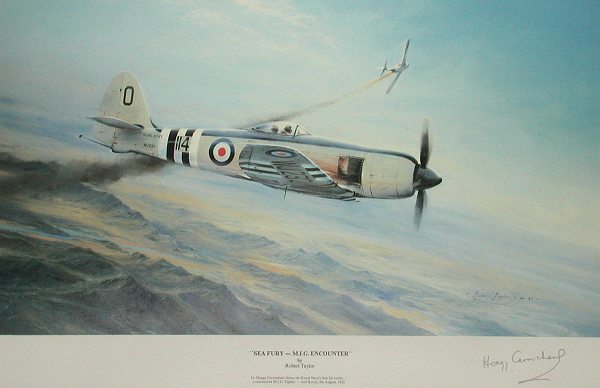
Had the Hawker Sea Fury arrived on the scene one year earlier than it did, its place in history would not be assured by its technical excellence but rather by the outstanding combat record it would undoubtedly have achieved with the British Pacific Fleet in the final struggles of 1945. As it is, the Sea Fury - designed for air superiority - is known for shooting down only one opponent, a MiG-15 shot down August 2, 1952, by Lt. Peter "Hoagy" Carmichael of 802 Squadron. Given that in the intervening five years between its appearance in squadron strength and that day in 1952 technological development had rendered the Sea Fury obsolete, its victory over the MiG is even more remarkable. As it is, the Sea Fury is the penultimate result of Sir Sidney Camm's philosophy of piston-engine fighter design.
 The Sea Fury began
life in 1942 with a request by the Air Ministry that Hawker Aircraft design a
long-range fighter for operations in the Far East. While a radial-engine
version of the Tempest was under development at the time, it was thought that
the relatively high wing-loading of the Tempest would be ill-suited for combat
with the lightly-loaded Japanese fighters, and thus the Sea Fury started out as
the "Tempest Light Fighter (Centaurus)."
The Sea Fury began
life in 1942 with a request by the Air Ministry that Hawker Aircraft design a
long-range fighter for operations in the Far East. While a radial-engine
version of the Tempest was under development at the time, it was thought that
the relatively high wing-loading of the Tempest would be ill-suited for combat
with the lightly-loaded Japanese fighters, and thus the Sea Fury started out as
the "Tempest Light Fighter (Centaurus)."
In early 1943, the designers were directed to adapt the fighter for shipboard operation as well as the land-based role. The first RAF prototype flew in September 1944, while the first navalized prototype flew in February 1945. Tests revealed a need for an increase in vertical fin and rudder size to counter the swing on take-off, while the rigid engine mounts created difficulty until they were replaced with dynafocal-base mounts which completely eliminated the vibration at lower speeds that had hampered the airplane's ability to land aboard ship.
While the Royal Navy was testing both the Meteor and the Vampire and had ordered the Supermarine Attacker, there was sufficient doubt about the ability of jets to operate off carriers that - while the RAF cancelled the land-based Fury - the Royal Navy continued to develop the Sea Fury as a shipboard interceptor and later fighter-bomber. With carrier compatibility trials completed in 1947, 807 Squadron converted to the aircraft, followed by 802, 803 and 805 Squadrons between August 1947 and February 1948. The initial Sea Fury Mk.X was quickly replaced by the F.B.11, which could carry underwing drop tanks, bombs and rockets; squadrons began to equip with it in May 1948.
The Sea Fury's introduction to combat came in the fall of 1950 when 807 Squadron, operating from HMS "Theseus," joined Task Force 95, the Korean blockade force. Operating jointly with Firefly F.R.IV and V strike aircraft, FAA Sea Furies flew from HMS "Triumph," "Theseus," "Glory," and "Ocean," as well as with the RAN from HMAS "Sydney" until the end of the war in July 1953. In typical operations, the carrier was "on line" for 11 days - 4 days of operations followed by 3 days of replenishment followed by a final 4 days of operations; at least two missions per day were flown by each operational aircraft aboard. These were missions in support of ground troops, or against rail and road transport to choke off supplies to the Chinese and North Koreans.
 HMS "Ocean" came
on-line in May, 1952, with 802 Squadron equipped with Sea Furies. By July and
August, enemy jet incursions over North Korea to intercept UN fighter-bomber
sorties began to increase. On August 2, eight MiG-15s hit the mixed strike
force of Sea Furies and Fireflies. Combat was sharp, with one Firefly destroyed
by the a MiG's heavy cannon fire, but the Sea Furies managed to hit two jets,
one of which crashed. Lt. Peter "Hoagy" Carmichael, Blue Section leader, was
credited with the kill. (Your editor has a signed Robert Taylor lithograph
of this action in a place of honor above his workbench. See the top of the
review.) The following day saw 8 more MiGs come after the Sea Furies, who
saved themselves by using tight maneuvers and taking advantage of cloud cover.
One MiG was claimed damaged.
HMS "Ocean" came
on-line in May, 1952, with 802 Squadron equipped with Sea Furies. By July and
August, enemy jet incursions over North Korea to intercept UN fighter-bomber
sorties began to increase. On August 2, eight MiG-15s hit the mixed strike
force of Sea Furies and Fireflies. Combat was sharp, with one Firefly destroyed
by the a MiG's heavy cannon fire, but the Sea Furies managed to hit two jets,
one of which crashed. Lt. Peter "Hoagy" Carmichael, Blue Section leader, was
credited with the kill. (Your editor has a signed Robert Taylor lithograph
of this action in a place of honor above his workbench. See the top of the
review.) The following day saw 8 more MiGs come after the Sea Furies, who
saved themselves by using tight maneuvers and taking advantage of cloud cover.
One MiG was claimed damaged.
Following the end of the Korean War, the Sea Fury was rapidly replaced by its successor, the Hawker Sea Hawk, and became the primary aircraft assigned to the RNVR "weekend warrior" squadrons.
The Sea Fury was also used by the Royal Australian Navy, the Royal Canadian Navy, the Royal Netherlands Navy, the Pakistani Air Force, the Iraqi Air Force and the Cuban Air Force; it last saw combat when flown by Cuban pilots of the FAR against the Cuban exile invasion attempt at the Bay of Pigs in April 1961.
In the mid 1960s, ex-Canadian Sea Furies began appearing in the U.S. civil aviation fleet, and the airplane made a name for itself as an air racer in the years following. While the Centaurus-powered Sea Fury was never really competitive with the Mustang and Bearcat in the short-distance pylon races at Reno, the reliability of the engine at high revs over long periods saw Sea Furies dominate long distance races like the California 1000. When the airplane was modified to accept the R-4360 four-row "corncob," it became a real competitor at Reno.
To me, there are few airplanes that look or sound better going overhead at an altitude of 100 feet or so than a Sea Fury.
|
THE KIT |
When Hobbycraft announced themselves in the late 1980s with the release of a 1/48 Sea Fury F.B.11, the kit's only competitor was a very good vacuform that had been released around 1985 or so by Falcon in New Zealand. Many modelers were very happy with this, even when it was discovered that the kit was pretty basic. In those days that was more what one expected, and any "detailing" of the cockpit was done through the application of a No.11 X-acto blade to Evergreen sheet plastic and the use of some modeling skills. Given that the cockpit was flat black, one could get away with quite a bit. Other complaints about the kit involved the use of heavy-handed "trenches" for panel lines on the wings. However, without too much extra effort, a good-looking model could be created, and with the Sea Fury's history of use by different air forces, the decal aftermarket soon supplied some nice-looking possibilities for final finish.
In the late 1990s, Hobbycraft re-released the Sea Fury kit with decals far superior to the initial offering. The "Korean War" kit includes full markings for Peter Carmichael's MiG-killer, as well as an all-blue Royal Australian Navy Sea Fury, and another from the Royal Netherlands Navy, the last to use it operationally. A separate release includes decals for a Royal Canadian Navy Sea Fury and another Dutch airplane.
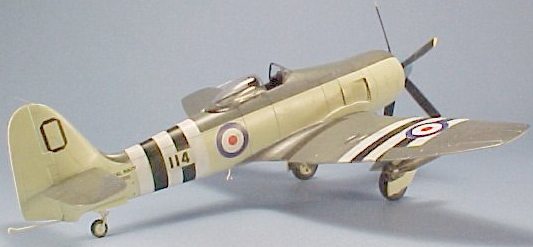 As the detail
aftermarket developed, the Sea Fury was one of the first to receive the
treatment. I recall a set of white metal corrected landing gear from War Eagle
that showed up in the early 1990s; when Squadron began releasing Falcon
vacuformed canopies, the Sea Fury set was one of the first.
As the detail
aftermarket developed, the Sea Fury was one of the first to receive the
treatment. I recall a set of white metal corrected landing gear from War Eagle
that showed up in the early 1990s; when Squadron began releasing Falcon
vacuformed canopies, the Sea Fury set was one of the first.
Around 1995 or so, Roy Sutherland came up with two resin detail sets for the Sea Fury that he released through Cooper Details. The sets were among those sold to Hawkeye designs a few years ago, and are now released by Cutting Edge since their acquisition of Hawkeye.
The Interior Set includes everything needed to create a detailed cockpit; as mentioned, with a flat black cockpit, a lot of detail can disappear, but you can see it yourself even if it doesn't lend itself well to model photography. The very good seat, with its molded-in seatbelts, is very visible - as Verlinden once said, if you only add a good seat to a cockpit, you greatly improve it, and this seat proves that.
The Exterior Set includes a prop spinner corrected for length and method of attaching the blades, correct-shape prop blades, a more detailed main wheel well, correct-size wheels and correct-length gear legs, correct-size drop tanks, and a better tailwheel.
For my project, I used both sets, and the "Korean War" release of the Hobbycraft kit, with a Falcon vacuformed canopy, provided by Mike Reeves' JetSet Models.
|
CONSTRUCTION |
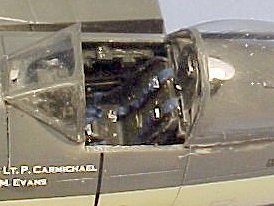 Like many projects,
construction begins with the cockpit. I airbrushed all the parts flat black,
then detailed them. I paid particular attention to the seat, since with its
olive green back cushion, yellow seat pad, and dark blue seat belts it would add
the most color to the cockpit as well as being the most-visible part. The
instructions that accompany the set are clear, precise and easy to understand.
Like many projects,
construction begins with the cockpit. I airbrushed all the parts flat black,
then detailed them. I paid particular attention to the seat, since with its
olive green back cushion, yellow seat pad, and dark blue seat belts it would add
the most color to the cockpit as well as being the most-visible part. The
instructions that accompany the set are clear, precise and easy to understand.
After the interior detail had been removed from the fuselage halves, I glued the cockpit into position, then glued the halves together. Be sure to glue the exhausts in position before closing up the fuselage, since it is just about impossible to do so afterwards.
Jetset Models had also
provided me with an Engines 'n' Things resin Centaurus, so I opened up the front
of the fuselage and installed it. This is a beautiful and accurate part,
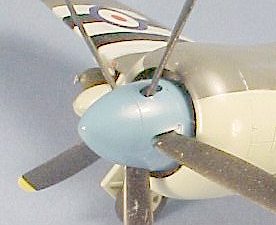 and
it is mostly wasted on a Sea Fury, given how closely it is cowled; with the
large spinner in front you can barely see anything. If you want to open
the cowl, this would be good to have, but you will have to scratchbuild the very
complex exhaust system.
and
it is mostly wasted on a Sea Fury, given how closely it is cowled; with the
large spinner in front you can barely see anything. If you want to open
the cowl, this would be good to have, but you will have to scratchbuild the very
complex exhaust system.
Once the engine was installed and the front of the cowl attached, I ran cyanoacrylate glue over all the seams in the fuselage, as the first step in getting rid of them.
I then turned to the wing, and the installation of the wheel well. Once it is removed from its molding block, the wheel well needs to be sanded down until the roof is paper-thin in order to fit inside the wing. Also, it does not have a forward wall; I cut off the forward wall from the kit wheel well and glued that in place first. Once the wheel well was in position, I glued the wing together and then glued the wing to the fuselage.
I also attached the
horizontal stabilizers at this point, and ran cyanoacrylate around
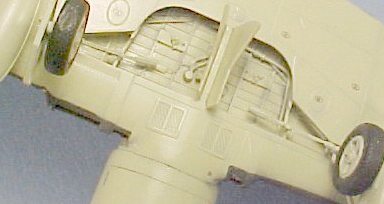 all the join seams.
all the join seams.
Once everything had set up and the CA was dry, I sanded down all the seams smooth, then applied Mr. Surfacer 500 to them. When that was hard, I sanded it down, checking the disappearance of seams by wetting the surface and holding it at an angle to the light. I reapplied Mr. Surfacer 500 where necessary and when I was happy with the seam situation I finished off with Mr. Surfacer 1000, lightly sanded with fine-grit wet 'r' dry. (As an aside, I have heard rumors that Mr. Surfacer has not been a "hit" in the model market and either is or soon will be out of production. To me this is the best stuff you can get for insuring a seam-free model; I intend to purchase it whenever and wherever I find it to stock up - if you agree with me about it, I suggest you do the same.)
|
PAINT & DECALS |
 I then painted the
upper camouflage, using Tamiya "Dark Grey" for Extra-Dark Sea Grey, and "fading"
it after the initial application. That was then masked off and the underside
Sky color was applied. I use Gunze-Sanyo's "Sky" color - which is lighter and
more yellow-toned than Tamiya's "Sky" (which is accurate for the WW2 color) -
for post-war FAA camouflage. This was also lightened and "faded" after initial
application.
I then painted the
upper camouflage, using Tamiya "Dark Grey" for Extra-Dark Sea Grey, and "fading"
it after the initial application. That was then masked off and the underside
Sky color was applied. I use Gunze-Sanyo's "Sky" color - which is lighter and
more yellow-toned than Tamiya's "Sky" (which is accurate for the WW2 color) -
for post-war FAA camouflage. This was also lightened and "faded" after initial
application.The box art shows Carmichael's airplane with a blue spinner, which would be accurate for him as Blue Section Leader. I have never seen any documentation of this, and the kit painting instructions say to paint it EDSG, but none of the FAA "color boffins" I know could say for sure it wasn't this way, and two pointed out that there were known Korean War Sea Furies with red and yellow spinners - which would fit with Red and Yellow Flights - so I decided to follow the box art with this model since the result would look good. The particular shade of blue was a mixture of Tamiya "Sky Blue" and "Blue" to get a similar tone to the cover painting.
When all was dry I unmasked the model and found that - for once! - there was no touchup needed along the edges. On that happy note I gave the model two coats of Future.
Decals:
The kit decals for this model are excellent. They are thin, in register, and go on with no problems. Stenciling is included, which results in a good-looking model.
|
FINAL PARTS |
I applied light exhaust stains to the fuselage sides - the Centaurus being a relatively "clean" engine. I then attached the landing gear, drop tanks and bomb racks, as well as the completed spinner and prop. The cockpit canopy was cut open and attached using white glue. I used a piece of .010 wire for the whip antenna on the vertical fin.
|
CONCLUSIONS |
The aftermarket items create a very accurate model. If you want one Sea Fury in your collection that is "definitive," then these are well worth the fact they more than triple the cost of the model over doing one OOB. However, if you want a collection of Sea Furies in all the beautiful livery possibilities, then I would recommend doing the kit OOB - with just a bit of effort to correct some notable blunders, you can have a very acceptable "markings model."
August 2002
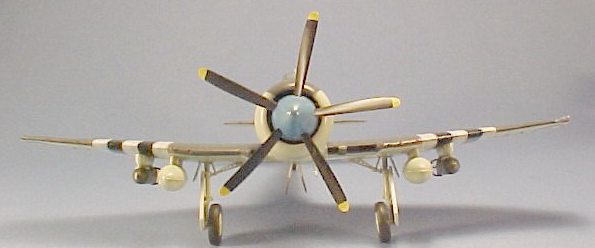
Thanks to JetSet Models for providing the review kit. Mike Reeves provides excellent prices and service.
Thanks to Meteor Productions for providing the Aftermarket Sets.If you would like your product reviewed fairly and quickly by a site that has well over 150,000 visitors a month, please contact me or see other details in the Note to Contributors.